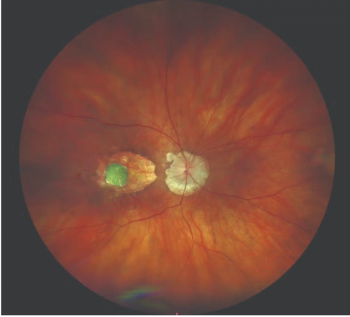
- Modern Retina May and June 2025
- Volume 5
- Issue 2
Multiple intravitreal injections and their effect on the optic nerve head in patients with CRVO
Research from the iMIND lab at Duke University.
As a medical student, I have had the opportunity to join the iMIND lab at Duke University and contribute to the growing and captivating neuro-ophthalmology field, which expands our understanding of the central nervous system to include ocular pathologies. I became involved with an interesting project investigating how the optic nerve head (ONH) endures morphological changes in eyes with central retinal vein occlusion (CRVO) after at least 12 anti-VEGF injections. My coauthors—Tammy Hsu, MD; Jane Kim, MD, MPH; Akshay Thomas, MD, MS; Dilraj Grewal, MD, FASRS; Mohsin Ali, MD; and Sharon Fekrat, MD, FACS, FASRS—have been essential in this project.
Anti-VEGF injections are reliable treatments and commonly utilized in clinic for patients with CRVO. While there is no debate that anti-VEGF therapy is essential in CRVO care, we know that patients may have transient or short sustained increases in IOP after treatment from previously conducted clinical trials.1,2
Our research attempts to dive into the questions: Do repeated intravitreal injections potentially affect the optic nerve head over time in eyes with CRVO, and are these seen in CRVO eyes specifically or also in eyes with
Our study analyzes the optic nerve by looking at 2 key metrics: Bruch membrane to anterior lamina cribrosa distance (BM-ALC) and prelaminar tissue thickness (PLTT). BM-ALC represents ONH depth and may indicate anterior lamina cribrosa displacement, while PLTT, defined as the tissue thickness from the ONH surface to the lamina cribrosa, reflects neuro-retinal structural integrity.3
We specifically looked at CRVO eyes as prior research indicates that the lamina cribrosa, a sieve-like structure in the ONH, may be a vulnerable site to damage or deformation in CRVO eyes.4,5 Deformation of the ONH at the lamina cribrosa has been implicated in the pathogenesis of glaucoma and may also represent an unintended consequence of repeated intravitreal anti-VEGF injections.6 Our study aimed to understand if CRVO eyes have a unique anatomic susceptibility, which may cause ONH changes. Eyes with wet AMD and untreated fellow eyes were included as control groups to help isolate the potential structural effects of repeated anti-VEGF injections on the ONH, independent of CRVO-related disease processes.
In our retrospective study, 20 eyes with CRVO, 19 untreated fellow eyes, and 10 wet AMD eyes were included and analyzed. CRVO and wet AMD eyes received at least 12 intravitreal injections over at least 1 year. Spectral Domain Optical Coherence Tomography scans were obtained through the Heidelberg Spectralis imaging platform to calculate BM-ALC and PLTT values for each eye at the initial appointment and final follow-up.Multiple intravitreal injections may result in ONH structural changes, particularly in eyes with CRVO, and provide insight into monitoring the ONH during long-term intravitreal pharmacotherapy.
In reviewing the data, we saw a few interesting findings and are excited to share these specific outcomes at the Women in Ophthalmology Summer Symposium. In addition to our research, larger prospective studies may further explore and clarify the clinical relationship between prolonged anti-VEGF therapy and changes to the ONH and lamina cribrosa in CRVO eyes.
Rachel D’Cunha
D’Cunha is an MD candidate, class of 2027, at Duke University School of Medicine and a member of the Duke iMIND Research Group. This multidisciplinary group is working to understand the potential of multimodal retinal images combined with machine learning techniques. The group works under its director, Sharon Fekrat, MD, FACS, FASRS, and other university faculty.
References
Bakri SJ, Moshfeghi DM, Francom S, et al. Intraocular pressure in eyes receiving monthly ranibizumab in 2 pivotal age-related macular degeneration clinical trials. Ophthalmology. 2014;121(5):1102-1108. doi:10.1016/j.ophtha.2013.11.029
Rebolleda G, Puerto B, de Juan V, Gomez-Mariscal M, Munoz-Negrete FJ, Casado A. Optic nerve head biomechanic and IOP changes before and after the injection of aflibercept for neovascular age-related macular degeneration. Invest Ophthalmol Vis Sci. 2016;57(14):5688-5695. doi:10.1167/iovs.16-20111
Rebolleda G, Pérez-Sarriegui A, Díez-Álvarez L, De Juan V, Muñoz-Negrete FJ. Lamina cribrosa position and Bruch’s membrane opening differences between anterior ischemic optic neuropathy and open-angle glaucoma. Eur J Ophthalmol. 2019;29(2):202-209. doi:10.1177/1120672118782101.
Ehlers JP, Fekrat S. Retinal vein occlusion: beyond the acute event. Surv Ophthalmol. 2011;56(4):281-299. doi:10.1016/j.survophthal.2010.11.006
Son Y, Lee S, Park J. Measurement of lamina and prelaminar thicknesses of both eyes in patients with unilateral branch retinal vein occlusion. Graefes Arch Clin Exp Ophthalmol. 2017;255(3):503-508. doi:10.1007/s00417-016-3491-y
Yang H, Thompson H, Roberts MD, et al. Deformation of the early glaucomatous monkey optic nerve head connective tissue after acute IOP elevation in 3-D histomorphometric reconstructions. Invest Ophthalmol Vis Sci. 2011; 52:345-363. doi:10.1167/iovs.09-5122
Articles in this issue
6 months ago
Highlights from ARVO 20257 months ago
Drugs to treat GA: Yes, please!7 months ago
Pearls for engaging in clinical trialsNewsletter
Keep your retina practice on the forefront—subscribe for expert analysis and emerging trends in retinal disease management.












































